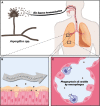Recent Advances in Fungal Infections: From Lung Ecology to Therapeutic Strategies With a Focus on Aspergillus spp
- PMID: 35386908
- PMCID: PMC8977413
- DOI: 10.3389/fmed.2022.832510
Recent Advances in Fungal Infections: From Lung Ecology to Therapeutic Strategies With a Focus on Aspergillus spp
Abstract
Fungal infections are estimated to be the main cause of death for more than 1.5 million people worldwide annually. However, fungal pathogenicity has been largely neglected. This is notably the case for pulmonary fungal infections, which are difficult to diagnose and to treat. We are currently facing a global emergence of antifungal resistance, which decreases the chances of survival for affected patients. New therapeutic approaches are therefore needed to face these life-threatening fungal infections. In this review, we will provide a general overview on respiratory fungal infections, with a focus on fungi of the genus Aspergillus. Next, the immunological and microbiological mechanisms of fungal pathogenesis will be discussed. The role of the respiratory mycobiota and its interactions with the bacterial microbiota on lung fungal infections will be presented from an ecological perspective. Finally, we will focus on existing and future innovative approaches for the treatment of respiratory fungal infections.
Keywords: aspergillosis; chronic respiratory disease; disease management; environmental interference; live biotherapeutic products; microbiome; mycobiome.
Copyright © 2022 Palmieri, Koutsokera, Bernasconi, Junier, von Garnier and Ubags.
Conflict of interest statement
The authors declare that the research was conducted in the absence of any commercial or financial relationships that could be construed as a potential conflict of interest.
Figures




Similar articles
-
The Fungal and Bacterial Interface in the Respiratory Mycobiome with a Focus on Aspergillus spp.Life (Basel). 2023 Apr 14;13(4):1017. doi: 10.3390/life13041017. Life (Basel). 2023. PMID: 37109545 Free PMC article. Review.
-
The potential impact of the pulmonary microbiome on immunopathogenesis of Aspergillus-related lung disease.Eur J Immunol. 2014 Nov;44(11):3156-65. doi: 10.1002/eji.201344404. Epub 2014 Oct 27. Eur J Immunol. 2014. PMID: 25256637 Review.
-
Crossing Kingdoms: How the Mycobiota and Fungal-Bacterial Interactions Impact Host Health and Disease.Infect Immun. 2021 Mar 17;89(4):e00648-20. doi: 10.1128/IAI.00648-20. Print 2021 Mar 17. Infect Immun. 2021. PMID: 33526565 Free PMC article. Review.
-
Chicken Intestinal Mycobiome: Initial Characterization and Its Response to Bacitracin Methylene Disalicylate.Appl Environ Microbiol. 2020 Jun 17;86(13):e00304-20. doi: 10.1128/AEM.00304-20. Print 2020 Jun 17. Appl Environ Microbiol. 2020. PMID: 32358003 Free PMC article.
-
Fungi in Bronchiectasis: A Concise Review.Int J Mol Sci. 2018 Jan 4;19(1):142. doi: 10.3390/ijms19010142. Int J Mol Sci. 2018. PMID: 29300314 Free PMC article. Review.
Cited by
-
How Does Airway Surface Liquid Composition Vary in Different Pulmonary Diseases, and How Can We Use This Knowledge to Model Microbial Infections?Microorganisms. 2024 Apr 3;12(4):732. doi: 10.3390/microorganisms12040732. Microorganisms. 2024. PMID: 38674677 Free PMC article. Review.
-
Interplay of Cytokines and Chemokines in Aspergillosis.J Fungi (Basel). 2024 Mar 27;10(4):251. doi: 10.3390/jof10040251. J Fungi (Basel). 2024. PMID: 38667922 Free PMC article. Review.
-
Targeting DNA Topoisomerase II in Antifungal Chemotherapy.Molecules. 2022 Nov 11;27(22):7768. doi: 10.3390/molecules27227768. Molecules. 2022. PMID: 36431868 Free PMC article. Review.
-
Clinical Aspergillus Signatures in COPD and Bronchiectasis.J Fungi (Basel). 2022 May 5;8(5):480. doi: 10.3390/jof8050480. J Fungi (Basel). 2022. PMID: 35628736 Free PMC article. Review.
-
Nanomedicines for Pulmonary Drug Delivery: Overcoming Barriers in the Treatment of Respiratory Infections and Lung Cancer.Pharmaceutics. 2024 Dec 11;16(12):1584. doi: 10.3390/pharmaceutics16121584. Pharmaceutics. 2024. PMID: 39771562 Free PMC article. Review.
References
-
- Suleyman G, Alangaden GJ. Nosocomial fungal infections: epidemiology, infection control, and prevention. Infect Dis Clin North Am. (2016) 30:1023–52. - PubMed
Publication types
LinkOut - more resources
Full Text Sources
Miscellaneous

